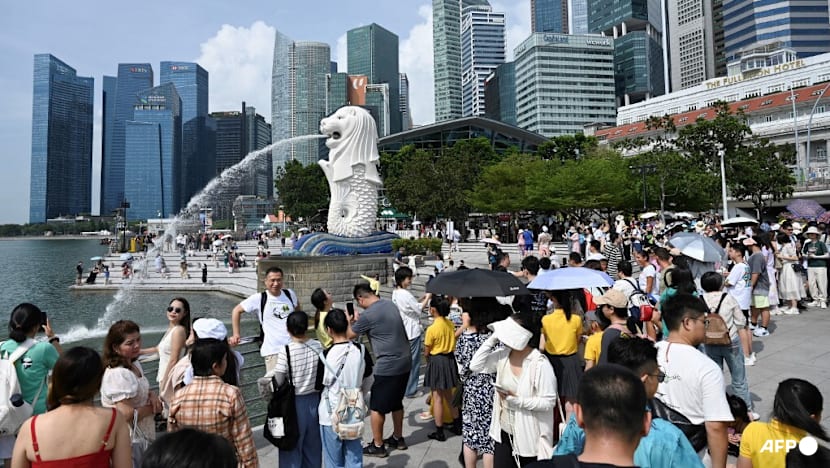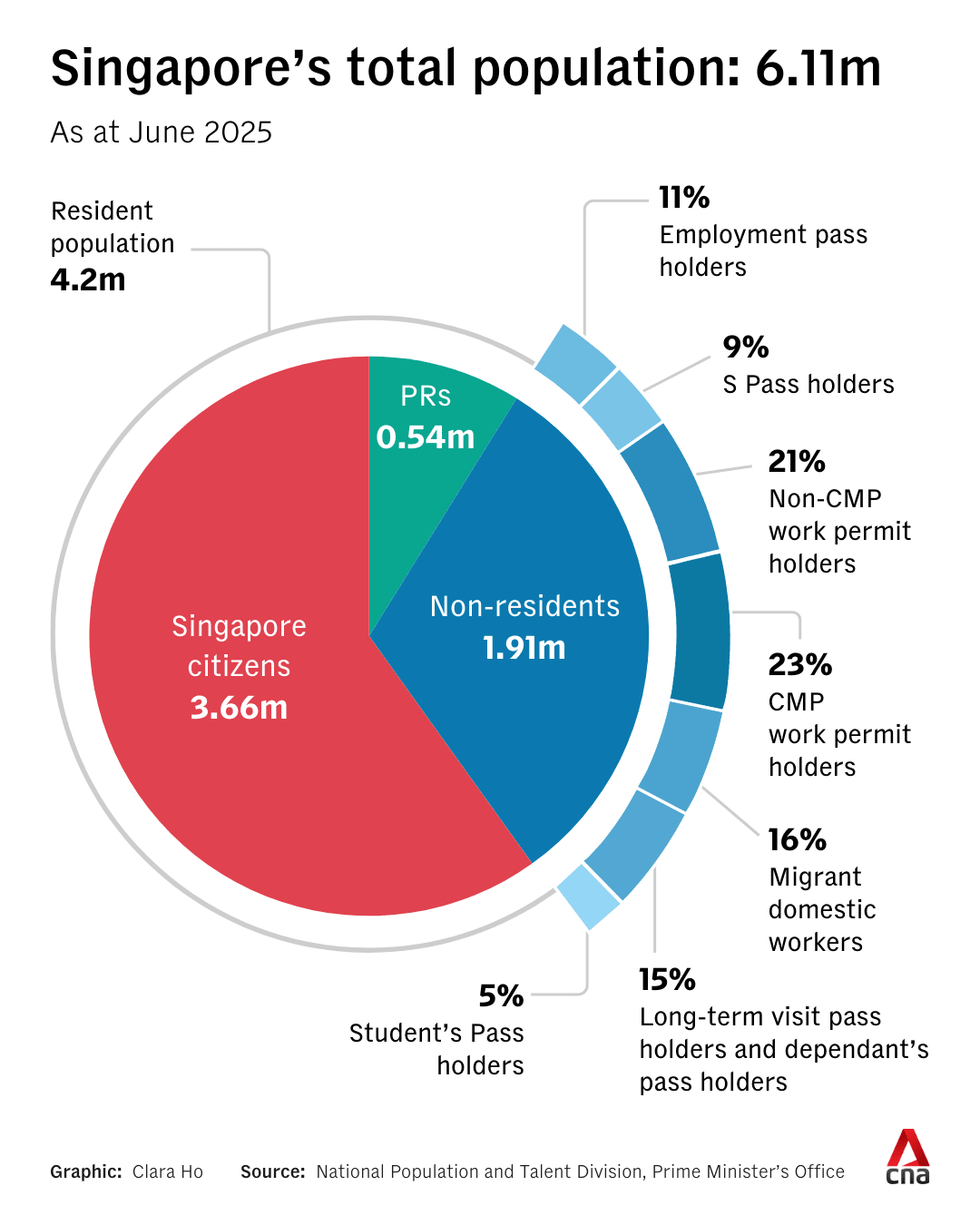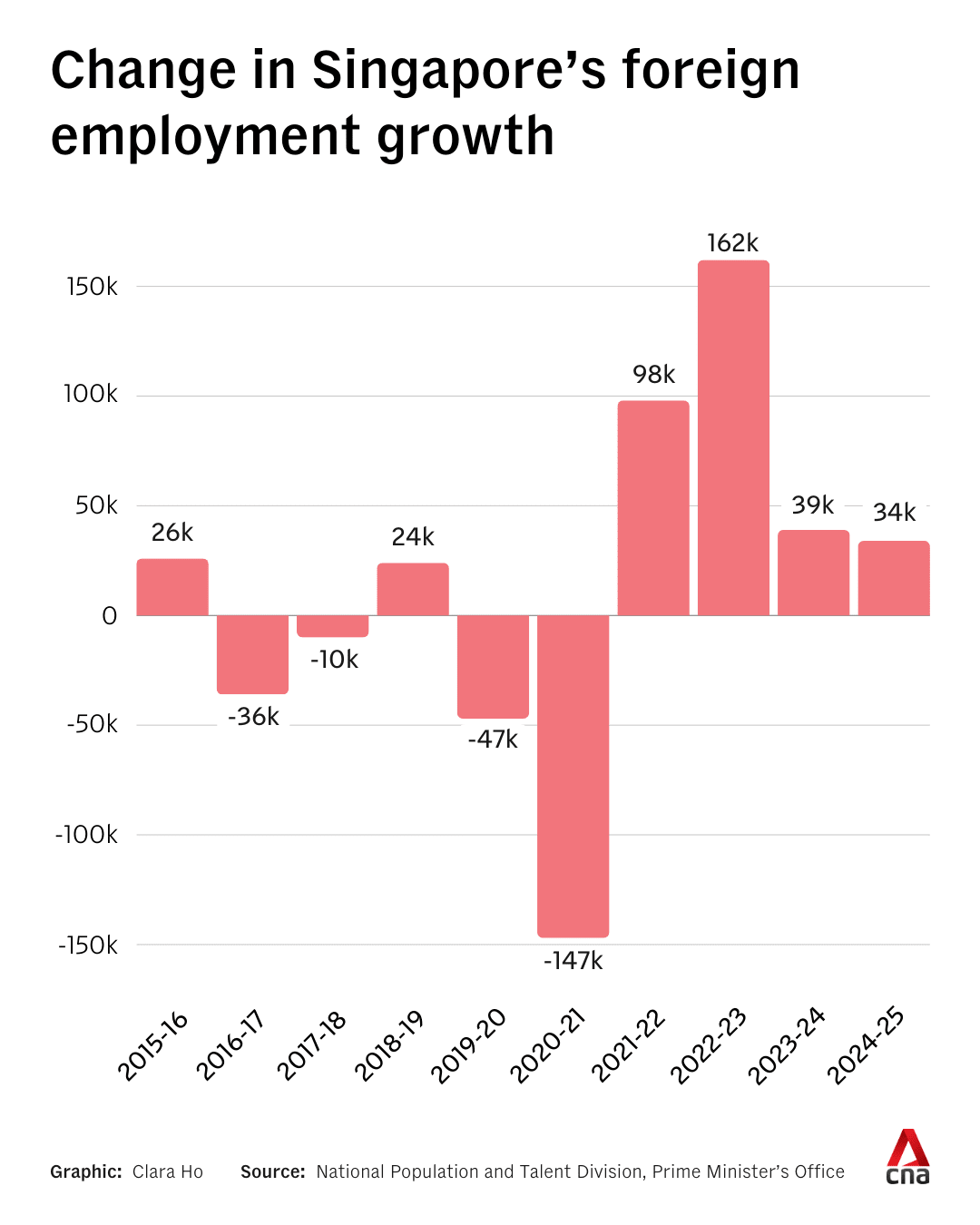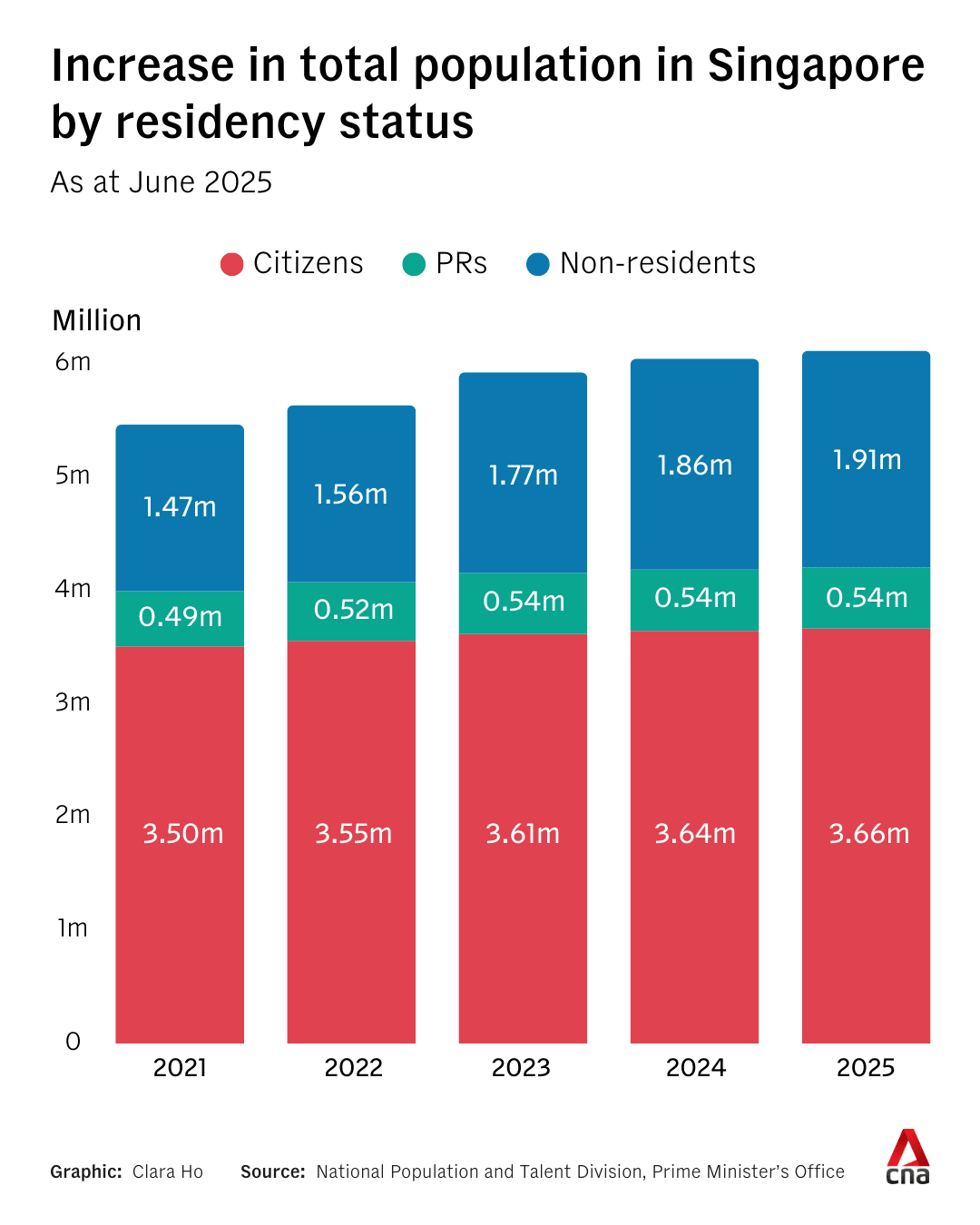Singapore's population hits new high of 6.11 million, increase mainly due to growth in non-resident population
Of the total population, about 3.66 million are Singaporeans and 0.54 million are permanent residents.

People gather next to the Merlion statue at the Marina Bay Waterfront Promenade in Singapore on Aug 7, 2024. (Photo: AFP/Roslan Rahman)

This audio is generated by an AI tool.
SINGAPORE: Singapore's total population hit a new high of 6.11 million as of June 2025, with the increase mainly due to the growth in the non-resident population.
This was a 1.2 per cent increase from June last year, when the total population exceeded 6 million for the first time.
The latest figures were published on Monday (Sep 29) in the annual Population in Brief report by the National Population and Talent Division (NPTD) of the Prime Minister’s Office and its partner agencies.
The non-resident population increased by 2.7 per cent from 1.86 million in June 2024 to 1.91 million in June 2025. The increase came primarily from work permit holders, followed by migrant domestic workers.
The pace of foreign employment growth in Singapore remained stable from June 2024 to June 2025, compared with June 2023 to June 2024, said the report.

The foreign workforce makes up about two-thirds of the non-resident population, while the remaining third comprises mainly maids, dependents and students.
"The non-resident population is diverse, and its size and composition fluctuate depending on our economic and social needs," the report said.
As of June 2025, there were 4.2 million Singapore residents – 3.66 million citizens and 0.54 million permanent residents (PRs).
The citizen population increased by 0.7 per cent from 3.64 million in June 2024, while the PR population remained stable.
Singapore's annualised population growth rate of 1.5 per cent over the past five years – from 2020 to 2025 – was higher than the 0.5 per cent over the preceding five-year period.
This was mostly due to an increase in the number of work permit holders in the construction sector to support key infrastructure projects such as Changi Terminal 5 and the ramping up of housing supply, the report said.

CITIZEN BIRTHS AND MARRIAGES
There were 29,237 citizen births in 2024, 1.2 per cent more than the 28,877 citizen births in 2023. Citizen births refer to babies born to at least one Singaporean parent.
The average number of births per year in the last five years (2020 to 2024) was 30,400, lower than the preceding five years, which stood at 32,900.
The median age of citizen mothers at first birth was 31.6 years in 2024, up from 30.3 years in 2014. The report said that the resident total fertility rate was 0.97 in 2024, unchanged from 2023.
Singaporean families are getting smaller, with fewer children per family, the report noted.
Over the past two decades, the share of citizen ever-married females without children or with one child has increased from 6.7 per cent to 14.4 per cent and 15.9 per cent to 22.8 per cent respectively.
Within the same period, the share of citizen ever-married females with three or more children decreased significantly from 34.5 per cent to 20.6 per cent.
"Decisions to get married and have children are deeply personal," said the report.
"As seen in many other advanced societies and observed in our surveys and engagements with Singaporeans, the trend of low fertility reflects a generational shift where younger Singaporeans value and prioritise other life goals ahead of marriage and parenthood.
"More Singaporeans are marrying later and delaying childbearing or choosing not to have children."
From the government's survey and engagements with Singaporeans, marriage and parenthood decisions are influenced by a "wide range of factors", including the costs of raising children, balancing work and family commitments, and expectations around what it means to be a good parent.

There were 22,955 citizen marriages in 2024, 5.7 per cent lower than the figure of 24,355 in 2023. This was still higher than the 22,165 in 2019, the report noted.
Citizen marriages refer to marriages involving at least one Singaporean.
The average number of citizen marriages per year in the last five years (2020 to 2024) was about 23,000, a drop from the 23,600 in the preceding five years.
The median age at first marriage for citizen grooms and brides was 30.8 and 29.1 years in 2024, up from 30.1 and 27.9 years respectively in 2014.
The report also provided data for transnational marriages and interethnic marriages in 2024. These made up 37 per cent and 19 per cent of citizen marriages respectively.
The report noted that the proportion of singles has been rising in recent years. Between 2019 and 2024, the proportion of singles rose across almost all male and female age groups.
"This trend is particularly pronounced in the younger age groups, with the 25 to 29 and 30 to 34 age groups registering higher increases in the proportion of singles, compared to other age groups," the report said.
The report said that despite the trends around marriage and birth, aspirations to marry and have children remain strong in Singapore.
According to the report, 80 per cent of young Singaporeans say they intend to marry, and over a third of married couples aspire to have three or more children.
"The government is committed to supporting Singaporeans’ parenthood aspirations, with a comprehensive suite of measures across areas such as housing, healthcare, preschool and education, financial and work-life support," it added.
AGEING POPULATION
The citizen population has continued to age, with 20.7 per cent aged 65 and above in June 2025, compared with 13.1 per cent a decade ago.
The number of citizens aged 80 and above also increased by about 60 per cent to 145,000 in 2025, up from 91,000 in 2015.
The proportion of the citizen population aged 65 years and above is rising at a faster pace compared to the last decade.
The median age of the population rose from 43.4 years to 43.7 years between June 2024 and June 2025.
There was also a drop in the percentage of citizens in the 20 to 64 years age group – from 64.5 per cent in 2015 to 59.8 per cent in June 2025.
By 2030, around 1 in 4 citizens - or 23.9 per cent - will be aged 65 and above.
"Immigration helps to moderate the impact of ageing and low birth rates on our citizen population, and keeps the citizen population from shrinking over the long term," said the report.
"Our PRs and new citizens also add to the vibrancy of Singapore’s society and economy."
The report said that the country takes in a "carefully controlled" number of PRs and new citizens each year, with all new adult citizens coming from the pool of PRs, as individuals have to obtain permanent residency before they may apply for citizenship.
In 2024, 22,766 people were granted citizenship and 35,264 individuals were granted permanent residency.
The average number of citizenships and permanent residencies granted per year over the last five years (2020 to 2024) was 21,300 and 33,000, respectively.
Those figures were slightly higher compared to the preceding five years, when 20,500 citizenships and 31,700 permanent residencies were granted.
"We are careful to grant citizenships and PRs to individuals who can contribute to Singapore, integrate well, and are committed to making Singapore their home," it said.
"Many of our new citizens and PRs either share family ties with Singaporeans (for example, through marriage), or have studied, worked or lived in Singapore for some time."
The report said the government will "continue to maintain a measured pace of immigration". The exact number of PRs and citizenships granted each year depends on several factors, including the number and quality of applications received and Singapore's changing needs.
















